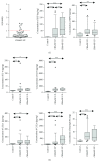Chronic Rhinosinusitis without Nasal Polyps in Asian Patients Shows Mixed Inflammatory Patterns and Neutrophil-Related Disease Severity
- PMID: 30766447
- PMCID: PMC6350559
- DOI: 10.1155/2019/7138643
Chronic Rhinosinusitis without Nasal Polyps in Asian Patients Shows Mixed Inflammatory Patterns and Neutrophil-Related Disease Severity
Abstract
Chronic rhinosinusitis (CRS) shows heterogeneous immunologic features. Western studies revealed that CRS without nasal polyps (CRSsNP) showed a predominantly type 1 immune response and CRS with nasal polyps (CRSwNP) was characterized by type 2 immune response; however, the detailed immunologic profile of CRSsNP in Asian patients has not been thoroughly investigated. Therefore, we investigated the inflammatory endotypes of CRSsNP in Asian patients. Patients with CRSsNP (N = 57), patients with CRSwNP (N = 13), and a control group (N = 10), who underwent endoscopic sinus surgery, were enrolled; uncinate process (UP) tissues were harvested from all patients. Homogenates were prepared from the UP of each group, and immunologic profiles were analyzed, including major cytokines (32 inflammatory mediators). When comparing the UPs between groups, CRSsNP patients showed higher levels of Th2 cytokines (IL-4 and IL-13), eosinophilic chemokines (CCL-11 and CCL-24), ECP, and total IgE expression than control subjects. In addition, several neutrophilic markers (IL-1α, IL-6, IL-8, CXCL-1, CXCL-2, and MPO), IL-17A, IL-22, and TNF-α were dominant in CRSsNP patients. Among these inflammatory mediators, IL-17A showed higher expression levels in CRSsNP patients than in the control group and CRSwNP patients. However, IFN-γ expression was not significantly elevated in CRSsNP patients. The levels of neutrophil-associated cytokines were well correlated with each other; of which, CXCL2, IL-8, and MMP-9/TIMP-1 levels were significantly correlated with disease extent (r = 0.338, r = 0.317, and r = 0.424, respectively). However, the levels of eosinophil-associated cytokines showed little correlation with each other and were not correlated with disease extent. Our study revealed that Asian CRSsNP patients showed a mixed (types 2 and 17) immune response, but neutrophil-related markers were dominant and associated with disease extent. Knowledge of this immunologic feature may help clinicians make better individual treatment decisions for Asian CRSsNP patients.
Figures





References
-
- Kim D. H., Han K., Kim S. W. Effect of chronic rhinosinusitis with or without nasal polyp on quality of life in South Korea: 5th Korea National Health and Nutrition Examination Survey Korean. Clinical and Experimental Otorhinolaryngology. 2016;9(2):150–156. doi: 10.21053/ceo.2015.01053. - DOI - PMC - PubMed
-
- Pleis J. R., Lucas J. W., Ward B. W. Summary health statistics for U.S. adults: National Health Interview Survey, 2008. Vital and Health Statistics. 2009;10(242):1–157. - PubMed
MeSH terms
Substances
LinkOut - more resources
Full Text Sources
Medical
Research Materials
Miscellaneous

